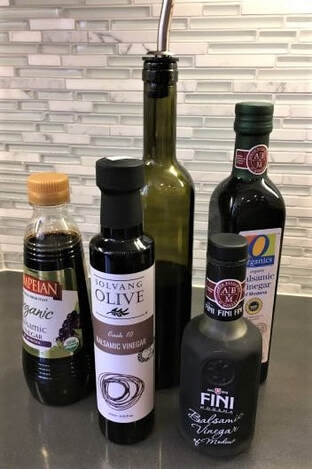 Balsamic Vinegars Balsamic Vinegars How you doin’? Here’s what I’m planning today. I’m going to grill steaks for dinner. I picked up a couple of bone-in rib-eye steaks at Huntington Meats yesterday and I lightly marinated them in what I thought to be expensive balsamic vinegar. It comes from a canister-like dispenser at Gelson’s markets and it costs about $35 bucks for a small bottle when they have it in stock. They make all kinds of claims they I never really paid much attention to; I just love the flavor of this brand of balsamic vinegar and use it on a lot of different things… I add it to salads and dressings, to sous vide chicken breasts, over-ripe strawberries, I even use it to add a punch to my Italian sauces and Bloody Mary Mix. I was a happy “balsamic camper” until I heard from George—George Salmas, The Food Lawyer. George exclusively represents food and beverage companies. The Food Lawyers have been in the biz for over 30 years advising and protecting food industry clients. We (Perspectives and The Food Lawyers) have common clients but do different things. Let me tell you a little bit about George… first of all, he is an attorney (that’s not all bad) with a quirky sense of humor and often writes about some of the really stupid things that people sue food people over. In California there are lots of litigious crackpots who will sue anyone at any time for anything… but I digress. So last week I receive a new article from George, Drop the Vinegar and Come Out With Your Hands Up! He goes on to tell us—well, I’ll let you read it in George’s own words (be sure to scroll down to the recipes below). Drop the Vinegar and Come Out With Your Hands Up! One of the great scams that has gone on for years, and still goes on today, is counterfeit balsamic vinegar. Most of it in stores is bogus. Real, traditional, authentic balsamic vinegar comes from two regions in Italy and starts with specific strains of white wine grapes that are crushed into juice with the skins, seeds and stems. This concoction is cooked down to about 50% volume into a concentrated syrup and then aged in a progression of barrels made from chestnut, cherry, oak, mulberry, ash or juniper for at least 12 years. Some of the premium products are aged for as many as 50 to 100 years. Well, this is all very expensive—and this is where the con-game begins. But this one is doubly tricky because it can be a double-con—one of which is actually legal. All crooks have two things in common. 1) They want to make as much money as possible with as little work as possible. 2) They are smarter than everybody else. So, they do things like rob banks, print counterfeit money and smuggle drugs. Some of them even go into politics. But those chumps are all pikers compared to the real gravy train: Food fraud. If you can take cheap food and palm it off as something exclusive, you can run that scam over, and over and over to the same people—forever (or until you get caught). Even when you catch them red handed, they act surprised and try to keep it going. One of the really great scams that has gone on for years and still goes on today, is counterfeit balsamic vinegar. Most of it in stores is bogus. Real, traditional, authentic balsamic vinegar comes from two regions in Italy and starts with specific strains of white wine grapes that are crushed into juice with the skins, seeds and stems. This concoction is cooked down to about 50% volume into a concentrated syrup and then aged in a progression of barrels made from chestnut, cherry, oak, mulberry, ash or juniper for at least 12 years. Some of the premium products are aged for as many as 50 to 100 years. Well, this is all very expensive—and this is where the con-game begins. But this one is doubly tricky because it can be a double-con—one of which is actually legal. The illegal con: Mostly originating in Italy, counterfeit balsamic starts out as “plonk” (cheap generic table wine grapes) that is palmed off as the expensive varieties. Then, it might be aged for a couple of years (or less) and then diluted with cheap white vinegar and pumped up with thickeners and coloring agents. The product is then labeled “balsamic vinegar” and sold without disclosing its sordid past. 3.38 oz of real 25-year-old balsamic vinegar can cost more than $150, and a bottle of 50-year-old can be $300. Even a bottle of 12-year-old (the minimum allowed) can go for $75. So, when it costs $10 or so to make a fake, that’s some serious profit. Last year, the Italian police conducted a sting and seized over 9 tons of bogus balsamic stock. And no one thinks they got all of it. The legal con: It’s OK to label something “balsamic vinegar” and put a bunch of bogus junk in it, so long as you list the bogus junk in the little ingredient statement on the back. Common additives are white vinegar, GMO brown sugar and caramel coloring. So here is a little advice from The Food Lawyers:
But there’s another alternative: If you like the cheap, watered-down stuff that’s normally served in Italian restaurants (it can actually taste pretty good), go ahead and use it. Just don’t pay $300 for 4 ounces. If you’ve got a problem and need legal food advice, call or email George Salmas, Phone: 310-556-0721 or email [email protected]. So, now that you know all the interesting “cons” relating to balsamic vinegar, here a couple of recipes you can make with it. For these two recipes you can use the “cheap” stuff. Inexpensive Balsamic Vinaigrette This is a great tasting balsamic vinaigrette that does not require the expensive, aged vinegar. It is simple and works well as a dressing or marinade. Prep time: 10 minutes Ingredients 1/2 cup olive oil 1/4 cup balsamic vinegar 1 teaspoon honey 1 teaspoon Dijon mustard 1 tablespoon shallot, minced 1 tablespoon garlic, minced salt and ground freshly-ground black pepper to taste Directions Combine the olive oil, balsamic vinegar, honey, Dijon mustard, shallot, garlic, salt and black pepper together in a glass jar with a lid. Shake vigorously until thoroughly combined. Boneless Balsamic Italian Beef Ingredients 1-3/4-pound boneless roast beef (chuck or round roast) 1 cup beef broth 1/2 cup balsamic vinegar 1 tablespoon Worcestershire sauce 1 tablespoon soy sauce 1 tablespoon honey 1/2 teaspoon red pepper flakes 4 cloves garlic, chopped Directions
ChefSecret: I keep any leftover cooking liquid in a Food Saver bag in the freezer and use it as a cooking starter for the next braised beef dish I make. Do you have a question or comment? Do you want to share a favorite recipe or pictures with our readers? Click here to send your thoughts. Please remember when making purchases—Give our American farmers and ranchers the business—source local foods, shop small (neighborhood owned stores) and buy when you see Made in the USA on the label. To you and everyone dear to you, be strong, be positive, stay well, stay safe and be kind. Thanks for reading! #BalsamicVinegar #BalsamicVinaigrette #ItalianBeef #Beef #Entrees #PerspectivesTheConsultingGroup #QuarantineKitchen #Covid19 #InstantPot #ComfortFoods #HuntingtonMeats #TheFoodLawyers
0 Comments
Your comment will be posted after it is approved.
Leave a Reply. |
For over 4 decades collaboration and vision have been the cornerstones of our approach to developing innovative solutions. We fuel innovation, uncover opportunities, discover trends and embrace sustainability, turning imaginative ideas into profitable realities. Categories
All
Archives
July 2024
|
www.perspectives-la.com
Copyright © 2021 Perspectives/The Consulting Group, LLC | Henderson, NV 89052 | 310-477-8877
Copyright © 2021 Perspectives/The Consulting Group, LLC | Henderson, NV 89052 | 310-477-8877


 RSS Feed
RSS Feed